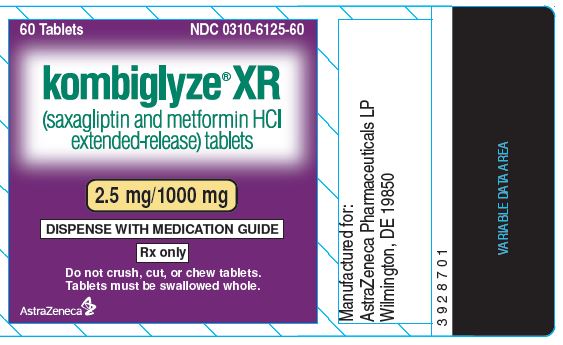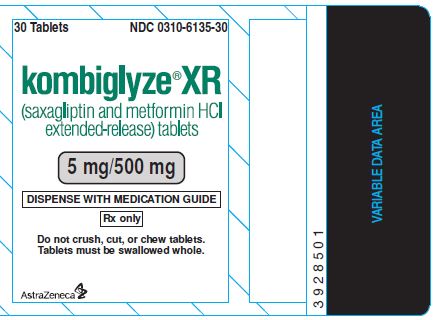Kombiglyze XR
Generic name: metformin and saxagliptin
Drug class: Antidiabetic combinations
Medically reviewed by A Ras MD.
What is Kombiglyze XR?
Kombiglyze XR is a prescription medicine that contains saxagliptin and metformin hydrochloride. Kombiglyze XR is used with diet and exercise to help control high blood sugar (hyperglycemia) in adults with type 2 diabetes.
Kombiglyze XR is not for people with type 1 diabetes. Kombiglyze XR is not for people with diabetic ketoacidosis (increased ketones in your blood or urine).
It is not known if Kombiglyze XR is safe and effective in children younger than 18 years old.
Description
KOMBIGLYZE XR (saxagliptin and metformin HCl extended-release) tablets contain two oral antihyperglycemic medications used in the management of type 2 diabetes: saxagliptin and metformin hydrochloride.
Saxagliptin
Saxagliptin is an orally active inhibitor of the dipeptidyl-peptidase-4 (DPP4) enzyme.
Saxagliptin monohydrate is described chemically as (1S,3S,5S)-2-[(2S)-2-Amino-2-(3-hydroxytricyclo[3.3.1.13,7]dec-1-yl)acetyl]-2-azabicyclo[3.1.0]hexane-3-carbonitrile, monohydrate or (1S,3S,5S)-2-[(2S)-2-Amino-2-(3-hydroxyadamantan-1-yl)acetyl]-2-azabicyclo[3.1.0]hexane-3-carbonitrile hydrate. The empirical formula is C18H25N3O2•H2O and the molecular weight is 333.43. The structural formula is:

Saxagliptin monohydrate is a white to light yellow or light brown, non-hygroscopic, crystalline powder. It is sparingly soluble in water at 24°C ± 3°C, slightly soluble in ethyl acetate, and soluble in methanol, ethanol, isopropyl alcohol, acetonitrile, acetone, and polyethylene glycol 400 (PEG 400).
Metformin hydrochloride
Metformin hydrochloride (N,N-dimethylimidodicarbonimidic diamide hydrochloride) is a white to off-white crystalline compound with a molecular formula of C4H11N5 • HCl and a molecular weight of 165.63. Metformin hydrochloride is freely soluble in water, slightly soluble in alcohol, and is practically insoluble in acetone, ether, and chloroform. The pKa of metformin is 12.4. The pH of a 1% aqueous solution of metformin hydrochloride is 6.68. The structural formula is:

KOMBIGLYZE XR
KOMBIGLYZE XR is available for oral administration as tablets containing either 5.58 mg saxagliptin hydrochloride (anhydrous) equivalent to 5 mg saxagliptin and 500 mg metformin hydrochloride (KOMBIGLYZE XR 5 mg/500 mg), or 5.58 mg saxagliptin hydrochloride (anhydrous) equivalent to 5 mg saxagliptin and 1000 mg metformin hydrochloride (KOMBIGLYZE XR 5 mg/1000 mg), or 2.79 mg saxagliptin hydrochloride (anhydrous) equivalent to 2.5 mg saxagliptin and 1000 mg metformin hydrochloride (KOMBIGLYZE XR 2.5 mg/1000 mg). Each film-coated tablet of KOMBIGLYZE XR contains the following inactive ingredients: carboxymethylcellulose sodium, hypromellose 2208, and magnesium stearate. The 5 mg/500 mg strength tablet of KOMBIGLYZE XR also contains microcrystalline cellulose and hypromellose 2910. In addition, the film coatings contain the following inactive ingredients: polyvinyl alcohol, polyethylene glycol 3350, titanium dioxide, talc, and iron oxides.
The biologically inert components of the tablet may occasionally remain intact during gastrointestinal transit and will be eliminated in the feces as a soft, hydrated mass.
12.1 Mechanism of Action
KOMBIGLYZE XR
KOMBIGLYZE XR combines two antihyperglycemic medications with complementary mechanisms of action to improve glycemic control in adults with type 2 diabetes: saxagliptin, a dipeptidyl-peptidase-4 (DPP4) inhibitor, and metformin hydrochloride, a biguanide.
Saxagliptin
Increased concentrations of the incretin hormones such as glucagon-like peptide-1 (GLP-1) and glucose-dependent insulinotropic polypeptide (GIP) are released into the bloodstream from the small intestine in response to meals. These hormones cause insulin release from the pancreatic beta cells in a glucose-dependent manner but are inactivated by the DPP4 enzyme within minutes. GLP-1 also lowers glucagon secretion from pancreatic alpha cells, reducing hepatic glucose production. In patients with type 2 diabetes, concentrations of GLP-1 are reduced but the insulin response to GLP-1 is preserved. Saxagliptin is a competitive DPP4 inhibitor that slows the inactivation of the incretin hormones, thereby increasing their bloodstream concentrations and reducing fasting and postprandial glucose concentrations in a glucose-dependent manner in patients with type 2 diabetes mellitus.
Metformin hydrochloride
Metformin improves glucose tolerance in patients with type 2 diabetes, lowering both basal and postprandial plasma glucose. Metformin decreases hepatic glucose production, decreases intestinal absorption of glucose, and improves insulin sensitivity by increasing peripheral glucose uptake and utilization. Unlike sulfonylureas, metformin does not produce hypoglycemia in patients with type 2 diabetes or in healthy subjects except in unusual circumstances and does not cause hyperinsulinemia. With metformin therapy, insulin secretion remains unchanged while fasting insulin levels and day-long plasma insulin response may actually decrease.
What is the most important information I should know about Kombiglyze XR?
Serious side effects can happen in people taking Kombiglyze XR, including:
1. Lactic acidosis. Metformin, one of the medicines in Kombiglyze XR, can cause a rare but serious condition called lactic acidosis (a build-up of an acid in the blood) that can cause death. Lactic acidosis is a medical emergency and must be treated in the hospital.
Call your doctor right away if you have any of the following symptoms, which could be signs of lactic acidosis:
- you feel cold in your hands or feet
- you feel dizzy or lightheaded
- you have a slow or irregular heartbeat
- you feel very weak or tired
- you have unusual (not normal) muscle pain
- you have trouble breathing
- you feel sleepy or drowsy
- you have stomach pains, nausea or vomiting
Most people who have had lactic acidosis with metformin have other things that, combined with the metformin, led to the lactic acidosis. Tell your doctor if you have any of the following, because you have a higher chance for getting lactic acidosis with Kombiglyze XR if you:
- have severe kidney problems or your kidneys are affected by certain x-ray tests that use injectable dye
- have liver problems
- drink alcohol very often, or drink a lot of alcohol in short-term “binge” drinking
- get dehydrated (lose a large amount of body fluids). This can happen if you are sick with a fever, vomiting, or diarrhea. Dehydration can also happen when you sweat a lot with activity or exercise and do not drink enough fluids
- have surgery
- have a heart attack, severe infection, or stroke
The best way to keep from having a problem with lactic acidosis from metformin is to tell your doctor if you have any of the problems in the list above. Your doctor may decide to stop your Kombiglyze XR for a while if you have any of these things.
Kombiglyze XR can have other serious side effects. See “What are the possible side effects of Kombiglyze XR?”
2. Inflammation of the pancreas (pancreatitis) which may be severe and lead to death.
Certain medical problems make you more likely to get pancreatitis.
Before you start taking Kombiglyze XR:
Tell your healthcare provider if you have ever had:
- inflammation of your pancreas (pancreatitis)
- a history of alcoholism
- stones in your gallbladder (gallstones)
- high blood triglyceride levels
It is not known if having these medical problems will make you more likely to get pancreatitis with Kombiglyze XR.
Stop taking Kombiglyze XR and contact your healthcare provider right away if you have pain in your stomach area (abdomen) that is severe and will not go away. The pain may be felt going from your abdomen through to your back. The pain may happen with or without vomiting. These may be symptoms of pancreatitis.
3. Heart failure. Heart failure means your heart does not pump blood well enough.
Before you start taking Kombiglyze XR:
Tell your healthcare provider if you
- have ever had heart failure or have problems with your kidneys.
Contact your healthcare provider right away if you have any of the following symptoms:
- increasing shortness of breath or trouble breathing, especially when you lie down
- swelling or fluid retention, especially in the feet, ankles or legs
- an unusually fast increase in weight
- unusual tiredness
These may be symptoms of heart failure.
Who should not take Kombiglyze XR?
Do not take Kombiglyze XR if you:
- have kidney problems.
- are allergic to metformin hydrochloride, saxagliptin, or any of the ingredients in Kombiglyze XR. See the end of this Medication Guide for a complete list of ingredients in Kombiglyze XR.
Symptoms of a serious allergic reaction to Kombiglyze XR may include:- swelling of your face, lips, throat, and other areas on your skin
- difficulty with swallowing or breathing
- raised, red areas on your skin (hives)
- skin rash, itching, flaking, or peeling
If you have these symptoms, stop taking Kombiglyze XR and contact your healthcare provider right away.
- have a condition called metabolic acidosis or diabetic ketoacidosis (increased ketones in your blood or urine).
What should I tell my healthcare provider before taking Kombiglyze XR?
Before taking Kombiglyze XR, tell your healthcare provider about all of your medical conditions, including if you:
- have type 1 diabetes. Kombiglyze XR should not be used to treat type 1 diabetes.
- have a history or risk for diabetic ketoacidosis (high levels of certain acids, known as ketones, in the blood or urine). Kombiglyze XR should not be used for the treatment of diabetic ketoacidosis.
- have kidney problems.
- have liver problems.
- have heart problems, including congestive heart failure.
- are older than 80 years. If you are over 80 years old you should not take Kombiglyze XR unless your kidneys have been checked and they are normal.
- drink alcohol very often, or drink a lot of alcohol in short-term “binge” drinking.
- are going to get an injection of dye or contrast agents for an x-ray procedure or if you are going to have surgery and will not be able to eat or drink much. In these situations, Kombiglyze XR may need to be stopped for a short time. Talk to your healthcare provider about when you should stop Kombiglyze XR and when you should start Kombiglyze XR again. See “What is the most important information I should know about Kombiglyze XR?”
- have any other medical conditions.
- are pregnant or plan to become pregnant. It is not known if Kombiglyze XR will harm your unborn baby. If you are pregnant, talk with your healthcare provider about the best way to control your blood sugar while you are pregnant.
- are breast-feeding or plan to breast-feed. It is not known if Kombiglyze XR passes into your breast milk. Talk with your healthcare provider about the best way to feed your baby while you take Kombiglyze XR.
Tell your healthcare provider about all the medicines you take, including prescription and over-the-counter medicines, vitamins, and herbal supplements. Know the medicines you take. Keep a list of them to show your healthcare provider and pharmacist when you get a new medicine. Kombiglyze XR may affect the way other medicines work, and other medicines may affect how Kombiglyze XR works.
Tell your healthcare provider if you will be starting or stopping certain other types of medicines, such as antibiotics, or medicines that treat fungus or HIV/AIDS, because your dose of Kombiglyze XR might need to be changed.
How should I take Kombiglyze XR?
- Take Kombiglyze XR exactly as your healthcare provider tells you.
- Kombiglyze XR should be taken with meals to help lessen an upset stomach side effect.
- Swallow Kombiglyze XR whole. Do not crush, cut, or chew Kombiglyze XR.
- You may sometimes pass a soft mass in your stools (bowel movement) that looks like Kombiglyze XR tablets.
- When your body is under some types of stress, such as fever, trauma (such as a car accident), infection, or surgery, the amount of diabetes medicine that you need may change. Tell your healthcare provider right away if you have any of these problems.
- Your healthcare provider should do blood tests to check how well your kidneys are working before and during your treatment with Kombiglyze XR.
- Your healthcare provider will check your diabetes with regular blood tests, including your blood sugar levels and your hemoglobin A1C.
- Follow your healthcare provider’s instructions for treating blood sugar that is too low (hypoglycemia). Talk to your healthcare provider if low blood sugar is a problem for you. See “What are the possible side effects of Kombiglyze XR?”
- Check your blood sugar as your healthcare provider tells you to.
- Stay on your prescribed diet and exercise program while taking Kombiglyze XR.
- If you miss a dose of Kombiglyze XR, take your next dose as prescribed unless your healthcare provider tells you differently. Do not take an extra dose the next day.
- If you take too much Kombiglyze XR, call your healthcare provider or go to the nearest hospital emergency room right away.
What are the possible side effects of Kombiglyze XR?
Kombiglyze XR can cause serious side effects, including:
- See “What is the most important information I should know about Kombiglyze XR?”
- Allergic (hypersensitivity) reactions, such as:
- swelling of your face, lips, throat, and other areas on your skin
- difficulty with swallowing or breathing
- raised, red areas on your skin (hives)
- skin rash, itching, flaking, or peeling
If you have these symptoms, stop taking Kombiglyze XR and contact your healthcare provider right away.
- Low blood sugar (hypoglycemia). May become worse in people who also take another medication to treat diabetes, such as sulfonylureas or insulin. Tell your healthcare provider if you take other diabetes medicines. If you have symptoms of low blood sugar, you should check your blood sugar and treat if low, then call your healthcare provider. Symptoms of low blood sugar include:
- shaking
- sweating
- rapid heartbeat
- change in vision
- hunger
- headache
- change in mood
- Joint pain. Some people who take medicines called DPP-4 inhibitors, one of the medicines in Kombiglyze XR, may develop joint pain that can be severe. Call your healthcare provider if you have severe joint pain.
- Skin reaction. Some people who take medicines called DPP-4 inhibitors, one of the medicines in Kombiglyze XR, may develop a skin reaction called bullous pemphigoid that can require treatment in a hospital. Tell your healthcare provider right away if you develop blisters or the breakdown of the outer layer of your skin (erosion). Your healthcare provider may tell you to stop taking Kombiglyze XR.
Common side effects of Kombiglyze XR include:
- upper respiratory tract infection
- stuffy or runny nose and sore throat
- urinary tract infection
- headache
- diarrhea
- nausea and vomiting
Taking Kombiglyze XR with meals can help lessen the common stomach side effects of metformin. If you have unexplained stomach problems, tell your healthcare provider. Stomach problems that start later during treatment may be a sign of something more serious.
These are not all of the possible side effects of Kombiglyze XR. Call your doctor for medical advice about side effects. You may report side effects to the FDA at 1-800-FDA-1088.
General information about the safe and effective use of Kombiglyze XR
Medicines are sometimes prescribed for purposes other than those listed in a Medication Guide. Do not use Kombiglyze XR for a condition for which it was not prescribed. Do not give Kombiglyze XR to other people, even if they have the same symptoms you have. It may harm them.
You can ask your pharmacist or healthcare provider for information about Kombiglyze XR that is written for health professionals.
How should I store Kombiglyze XR?
Store Kombiglyze XR between 68°F to 77°F (20°C to 25°C).
Keep Kombiglyze XR and all medicines out of the reach of children.
What are the ingredients in Kombiglyze XR?
Active ingredients: saxagliptin and metformin hydrochloride.
Inactive ingredients in each tablet: carboxymethylcellulose sodium, hypromellose 2208, and magnesium stearate.
The 5 mg/500 mg tablet also contains: microcrystalline cellulose and hypromellose 2910.
Tablet film coat contains: polyvinyl alcohol, polyethylene glycol 3350, titanium dioxide, talc, and iron oxides.
Label
PACKAGE/LABEL PRINCIPAL DISPLAY PANEL – 2.5 MG/1000 MG
- 60 Tablets NDC 0310-6125-60
kombiglyze® XR
(saxagliptin and metformin HCl - extended-release) tablets
2.5 mg/1000 mg
DISPENSE WITH MEDICATION GUIDE
Rx only
Do not crush, cut, or chew tablets. - Tablets must be swallowed whole.
AstraZeneca

PACKAGE/LABEL PRINCIPAL DISPLAY PANEL – 5 MG/500 MG
- 30 Tablets NDC 0310-6135-30
kombiglyze® XR
(saxagliptin and metformin HCl extended-release) tablets
5 mg/500 mg
DISPENSE WITH MEDICATION GUIDE
Rx only
Do not crush, cut, or chew tablets. - Tablets must be swallowed whole.
AstraZeneca

SRC: NLM .
